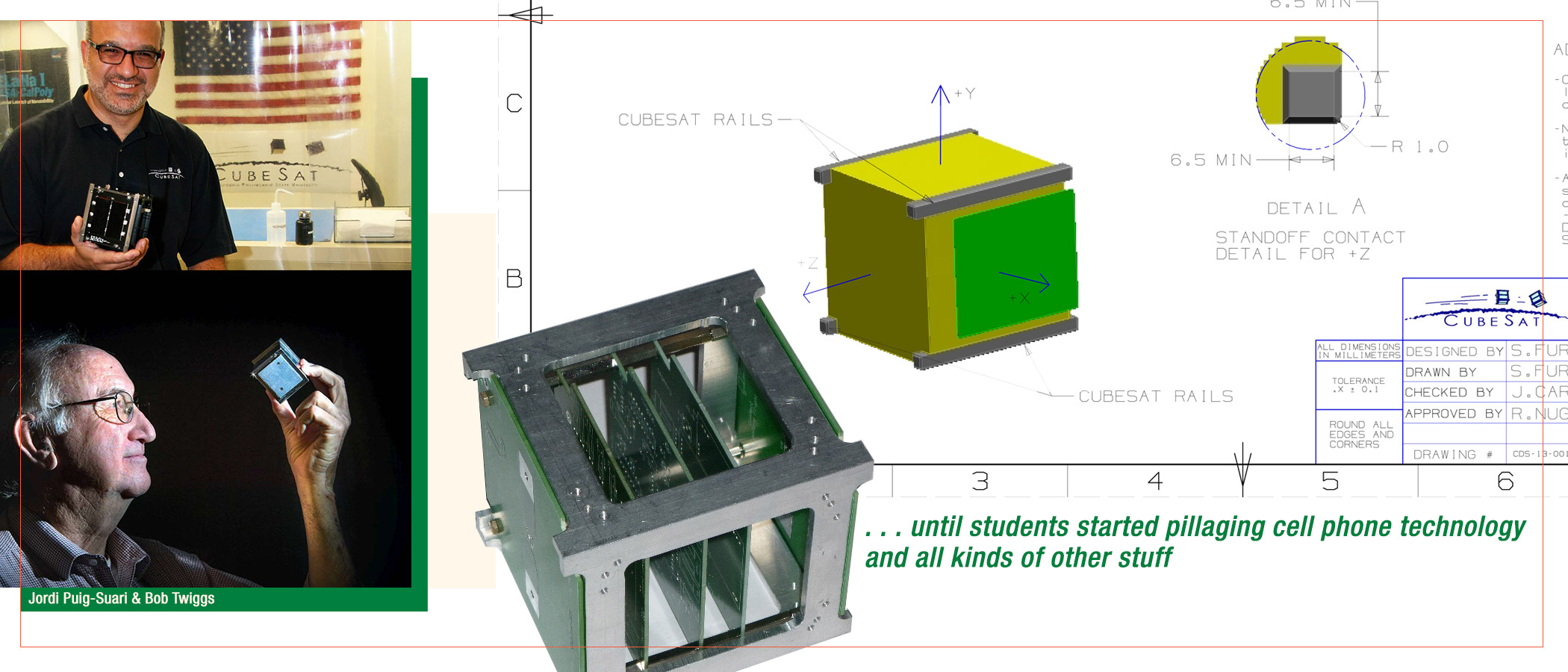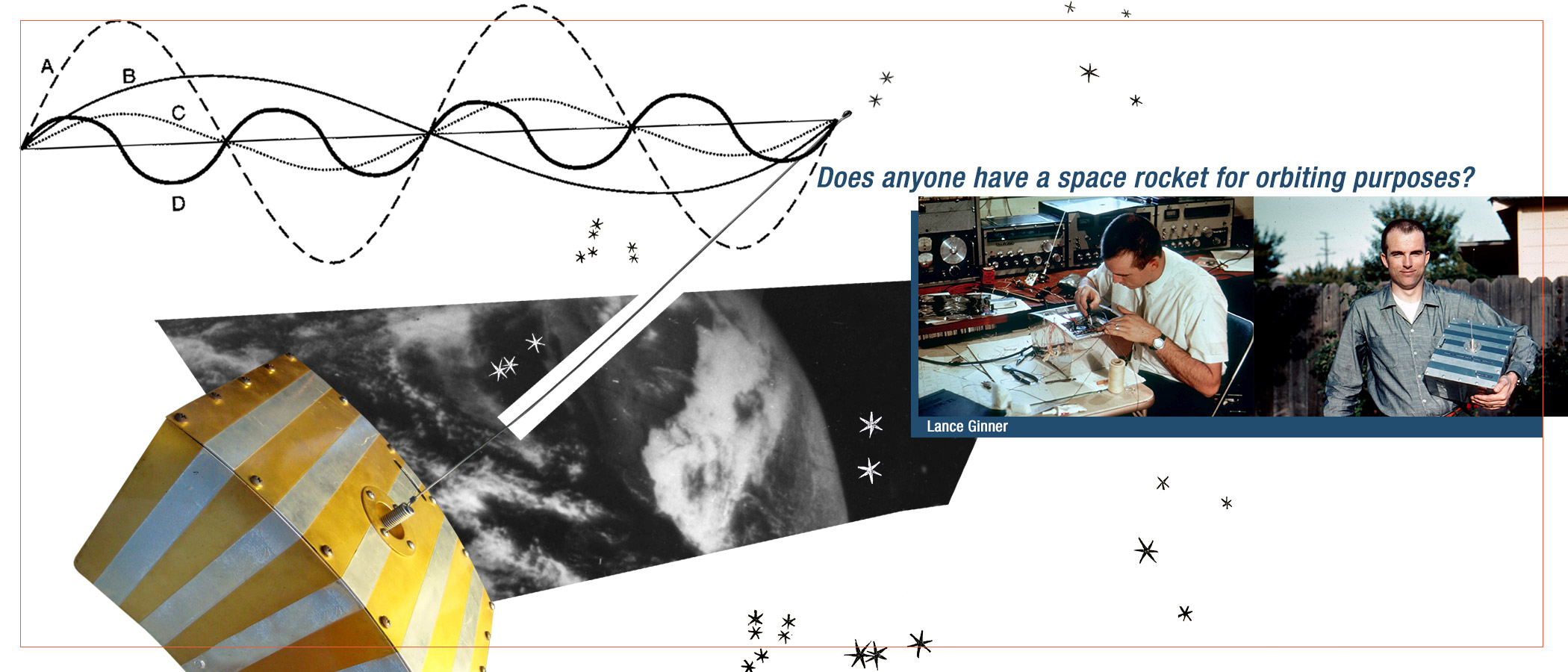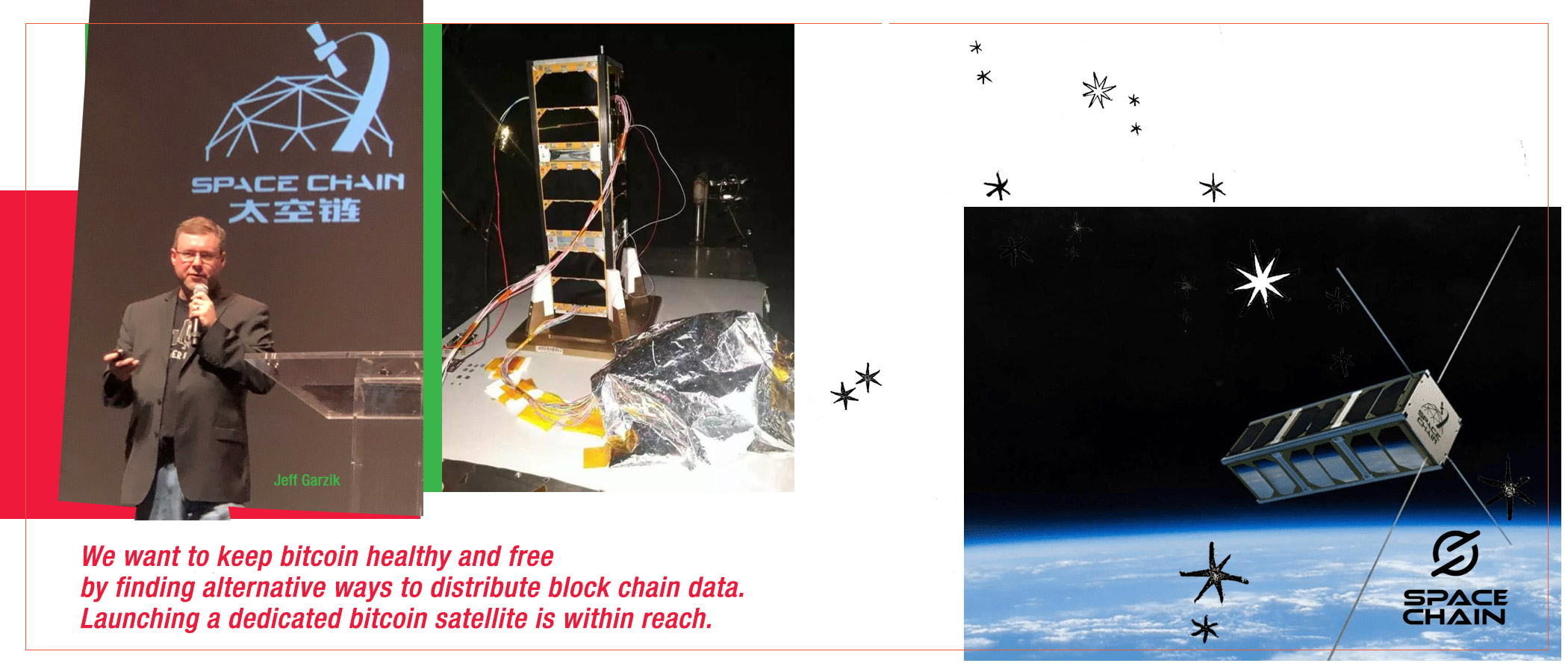
NANOSATELLITES,
THE UNTOLD STORY OF SPACE DEMOCRATIZATION
—Part 1 #Space4Everyone
November 22nd, 2019 · Nanosat Team
The access, exploration and use of outer space were the dominion of Earth’s most powerful states and big corporations, mostly military-oriented. Not anymore. The spacecrafts were getting bigger, more complex, and more expensive. Not anymore. His vision of conquest, colonization, and explotation also in space was the only one existing. Not anymore. The paradigms of Space Age are changing, significantly and deeply. How? Why? Who are the new protagonists?
NANOSAT, the first illustrated history of the nanosatellites, try to give us the clues of this paramount change which, ultimately, will also shape human life in Earth. Step by step, each “trading card” illustrate the milestones of this unexpected and fascinating story of space democratization, of space for everyone.

SMALL IS BEAUTIFUL
New approaches for space exploration become available with the smallest technology imaginable…
These days are the 31 anniversary of the successful launch of soviet space shuttle Buran on 15 november 1988. Aknowledged as the most perfect space shuttle ever built, Buran had also a perfect automatic fligth. During 17 years more than 6 million people worked in this colossal project, that built the most complex vehicle and performed the most expensive lauch in history. But this was their first and last mission! What happened to the Buran space shuttle? Valery Burdakov, that worked in Buran-Energya project, explained that “they closed down what was a successful and innovative project. In the end, 15 billion rubles was wasted. Like the (american) shuttle, the Buran was not financially viable because the launch system was expensive and clumsy.”
Buran finally was destroyed in the roof collapse of his hangar. And fifty years after their arrival to the Moon, the US astronauts goes to space in the veteran russian Soyuz spacecrafts! After the collapse of american space shuttle program, from 2011 onward, NASA has paid Russia $3.9 billion for ferrying astronauts to the International Space Station… These are a very eloquent example of the limits to growth, also in relation to space exploration. History shows us the need for new approaches and perspectives. The way forward is not forever the bigger, more complex, and more expensive launch vehicles and satellites.
New approaches for space exploration become available with the smallest technology imaginable… the nanotechnology! Nanosicence and nanotechnology were critical for the miniaturisation and the emergence of commercial off the shelf products that make nanosatellites posible and economically affordable. Specially, the emergence of smart phones, made possible by nanoelectronics, has driven a spectacular miniaturization of electronics. As a result, cheap commercial-off-the-shelf products made many of the components used in spacecraft available for everyone. Innovation is burgeoning in space exploration from new reusable rockets to manufacturing rockets and satellites using 3d printers with molten metallics, from the introduction of new concepts to the use of new materials... But microelectronics boom has been key for this changes. The underlying trend towards the digitalization of the world is also behind in the evolution of space technology and, moreover, in many more ways.

“PILLAGING CELL PHONE TECHNOLOGY”
Transforming the available smartphones, and all types of electronics commercial-off-the-shelf products, in the raw material to recreate the satellites.
Popularly, talking about nanosatellites is synonymous with talking about cubesats. CubeSat are recognized as the origin of the New Space revolution, this tiny spacecrafts have revolutionized the Space Age, challenging the traditional ways of space exploration. Many times qualified as “Bread-Loaf Size Satellites” or even “The Itty Bitty Satellite,” CubeSat are acclaimed today as the biggest thing in satellites since Sputnik. In the origin of CubeSat open-source standard is the passionate and collaborative work between professors Bob Twiggs and Jordi Puig-Suari, to ameliorate the aerospatial engineering student skills by performing real space projects.
The inspiration for the original model for CubeSat was… a plastic Beanie Baby box! The cube form is the most practical: without an attitude stabilization on the satellite, you have to have solar cells on all sides. And the most reduced size (at the epoch), was a 10-centimeter cube, to obtain a minimum of energy to power the spacecraft.
So a CubeSat is a 10 cm (4-inch) cube with a mass of up to 1.33 kg (2.93 pounds). CubeSats can be scaled from one to several units (“one unit” or “1U”, 2U, 3U… normally up to 12U). Inside this container we can put anything we want; the payload of the satellite. The CubeSat uses and ad-hoc orbital deployer, i.e. a “Poly-PicoSatellite Orbital Deployer” or P-POD for short. CubeSats are carried to space inside one of this orbital deployer. This compact packaging ensures at same time the safety of the CubeSat and protect the primary satellite on the launch vehicle. The International Space Station has their own CubeSat deployer and even some cargo vehicles to ISS has deployers too. Cubesats also easily can fit as a “secondary payload” in the current launch vehicles (until the recent appearance and boom of launchers exclusively dedicated to put smallsats in orbit). In the search of the most affordable solution for students, prolific Professor Twiggs created also the original concepts for the CricketSat, CanSat, PocketQube, and the ThinSat!
As Bob Twiggs put it, “It all started as a university education program satellite.” The question was: How to do something that students could afford during their master’s degree, in a period of about two years, to launch for a reasonable price? At the time, nor NASA nor any military organization nor aerospace industry had not interest and not funded the low cost alternative!!! Bob commented “I’m kind of glad that NASA didn’t help us, or we’d probably never got it done. It was developed for the education of students.” For its part, Jordi Puig-Suari gave a lecture with the self-explanatory title ‘CubeSat: An Unlikely Success Story.’
But Jordi Puig-Suari, co-inventor of CubeSat, explains the secret of their success: “When Bob and I started, we really wanted a Sputnik. We didn’t feel like there was much more these things could do until students started pillaging cell phone technology and all kinds of other stuff.” These innovative teachers gave the framework. And in this context, the curiosity, the desire to experience, the talent and ingenuity of young students and of all kind of tinkerers, makers, dyers, hackers, and space amateurs transformed the available smartphones, and all types of electronics commercial-off-the-shelf products, in the raw material to recreate the satellites. The space democratization is a fact. Beyond States and corporations, we can access to space even with personal satellites or by creating space agencies.

THE FORERUNNER OF NANOSATELLITES
It was built in the garages and basements of the project team members, using for the most part “components off the self.”
But the path to space democratization begin practically with the first steps of space exploration. The Orbiting Satellite Carrying Amateur Radio (OSCAR) was the world first civilian, private, non-government spacecraft.
In April, 1959, only two years after the launch of Sputnik 1, Don Stoner, that designed a transmitter successful at a distance of some 200 kilometers, wondered whether would work if it were 200 kms overhead in a satellite. So he asked, joking, in the ham radio publication, “Does anyone have a space rocket for orbiting purposes?”, with an astounding answer from hobbyists that crystallized in the formation of OSCAR project.
Lance Ginner, another of the radio amateurs of the project, explained that “the bureaucratic efforts probably exceeded those required to build the satellite.” But finally was launched on December 12, 1961, on a cover, classified (Top Secret) space mission Corona!
The satellite mass was 4.5 kilograms, in a curved --convex-- quasi rectangular box, a shape to adapt to the exterior surface of the rocket, with dimensions of 30 cm x 25 cm x 12 cm approximately. OSCAR 1 was built in the garages and basements of the project team members, using for the most part “components off the self.” Without counting donations of materials, the total cost of the satellite, that replicated the functionality of Sputnik 1, was $64 (or today $529).
The OSCAR 1 was the the world's first piggyback satellite, the first to be ejected as a “secondary payload.” It was used as ballast, in place of the weights necessary for balancing the payload in the rocket stage. Located near the engines, at the tail-end of the rocket, was ejected with a $1.15 spring from Sears Roebuck.
For three weeks --the duration of their batteries--, OSCAR 1 transmitted its Morse code “HI” (the greeting, and telegraphic laugh) from their small beacon transmitter at an speed based upon internal temperature of satellite.`
Fifty years ago, in 1969, was formed the Radio Amateur Satellite Corporation (as AMSAT is officially known) to continue the efforts of project OSCAR, keeping Amateur Radio in Space. “Today, the “home-brew” flavor of these early Amateur Radio satellites lives on, as most of the hardware and software now flying on even the most advanced AMSAT satellites is still largely the product of volunteer effort and donated resources. Though we are fond of traditions our designs and technology continue to push the outside of the envelope.” Up till today, there are 104 Orbiting Satellites Carrying Amateur Radio in orbit numbered by AMSAT.

THE WORLD’S SMALLEST SPACECRAFT
What happens when a space geek and a space hacker joined forces? The success of ChipSats, a paradigm shift.
“I'm turning science fiction into science fact,” said the “Space Geek, Inventor, Writer, Professor, Former Bureaucrat,” Mason Peck about what he learned from his science-fiction-writer dad. Peck, who was NASA’s chief technologist, is envisioning things such as democratize space exploration or make reality the interstellar exploration using chips as spacecrafts. An all-time achievement in miniaturisation and lowering the cost of spaceflight!
In their seminal, and thrilling article, “Exploring Space with Chip-sized Satellites” (2011), Mason Peck focus our attention to the fact that scaling something down to the size of a dust particle changes the gravity's effect. “This behavior is more than just a curiosity: It could have profound implications for space exploration. Spacecraft have been getting bigger and bigger for decades, ballooning in size to carry ever more impressive equipment. But if we can reverse that trend and instead build the tiniest spacecraft possible, we can create entirely new ways to study the solar system and beyond.” So in the fall of 2005 at Cornell University, Peck and then graduate student Justin Atchison conceived the Sprite project “to fit everything a satellite might need on a 1-square-centimeter integrated circuit.”
“But spacecraft-on-a-chip projects have very different aims from those of CubeSat and other such efforts. Our main goals are to exploit the physics of small objects and the power of mass production. In that sense, Sprite represents a paradigm shift.” The aim is to create a spacecraft with a propellantless propulsion, capable to take her to the Stars. The basic physics that would propel a Sprite is the same as for cosmic dust, like radiation pressure and electromagnetic forces. In this sense, the KickSat Sprite was proposed in 2016 as an early-stage prototype of the StarChip, the interstellar probe for the Breakthrough Starshot project. This is an initiative to prove ultra-fast light-driven nanocrafts, and lay the foundations for a first launch to Alpha Centauri within the next generation. Ad Astra!
Since the first test outside the International Space Station, passing by the KickSat-1 cubesat mission, until the successful deployment in orbit of a swarm of ChipSats, the Sprite project lead is “Roboticist, Engineer, and Spacecraft Hacker” Zac Manchester, with a crystal clear vision: “I want to make it easy and affordable enough for anyone to explore space. This is like the PC revolution for space. We’ve shown that it’s possible for swarms of cheap, tiny satellites to one day carry out tasks now done by larger, costlier satellites, making it affordable for just about anyone to put instruments or experiments into orbit.”
The chipsats attached to the outside of the space station in 2011 and 2012 proved that they can survive the rigours of space. Then, KickSat-1 cubesat mission in 2014 was to deploy over 100 Sprite spacecrafts (or ChipSats), with the size of a postage stamp. The space flight at its simplest! But a radiation induced reset of the timer postponed the deployment to a time after the reentry date of Kicksat-1 so the Sprites were not deployed in time, and burned up inside the mothership. The project was crowdfunded through Kickstarter, one of the first crowdfunded space projects: “KickSat -- Your personal spacecraft in space! Would you like to have your own spacecraft? Kickstart the personal space age by helping launch tiny spacecraft into low Earth orbit.” Finally, the success of KickSat 2 mission in March 2019 was a wonderful milestone in the evolution of nanosatellites, with operative centimeter-scale spacecrafts. The cubesat deployed up to 105 tiny Sprite satellites (femtosatellites) into low Earth orbit. The Sprites then transmited on 437.240 MHz at 10 mW, communicating with each other via a mesh network and with command stations on Earth. The KickSat-2 mission demonstrated that tiny, massively distributed satellites using commercial off-the-shelf technology can work in outer space. Now is feasible the vision of those who investigated the feasibility of sending chipsats to Jupiter’s moon Europa or planned to send suicide missions to explore hostile environments, such as Saturn’s rings. A new way to explore the Solar System and beyond is open.

BLOCKCHAIN IN SPACE
Blockchain is the next major disruptor in space.
There are currently quite a few projects studying the potential of decentralization technologies in space exploration from many different points of view: from Blockstream – broadcasts the Bitcoin blockchain using leased geosynchronous satellites – to research on autonomous deep space spacecraft based on blockchain granted by NASA, through projected EtherX spacecraft by XYO Networks – decentralized world’s location infrastructure alternative to GPS –; just to name a few different examples. But in this post we will focus attention on the pioneering work of one of the first Bitcoin developers that finally merged with the young people who put the first blockchain node into orbit, in a cubesat, and are building the world’s first open-source satellite network.
In 2013, Jeff Garzik, key Linux kernel engineer and key Bitcoin Core developer, began explaining publicly about plans to launch a small commercial satellite to serve as an orbiting bitcoin node, the not-for-profit BitSat project. As Mason Peck, Jeff Garzik was also inspired by his father. In an interview when was asked, “How long have you been interested in space?” Jeff answered, “I’ve been interested in space for as long as I can remember. My father flew fighter jets and worked on rockets early in his career. The Right Stuff was a favorite movie, as was Star Wars. Space fiction or space fact, it didn’t matter, I ate it up.”
So let's do it; Jeff Garzik created Dunvegan Space Systems, “a one-man mission to disrupt the spaceflight industry, through free market principles, bitcoin and engineering knowhow.” The plan was to have a node in space as a resilient backup in case of terrestrial failure for the Bitcoin network. The idea was to build a bitcoin orbital system, providing redundancy to the network and protecting the bitcoin network from attacks and network outage. “We want to keep bitcoin healthy and free by finding alternative ways to distribute block chain data. Launching a dedicated bitcoin satellite is within reach. I believe space holds the promise of our future, and also offers a lot of utility right now.”
In April 2014, Dunvegan Space Systems signed a contract with Deep Space Industries (now Bradford Space, Inc.) to build a 24 BitSat satellite constellation based on open-source principles. The BitSats would employ the CubeSat standard. There was a donation-supported campaign to build and launch the system. Finally the BitSat project stalled; it was cancelled when fundraising fell through. But the seminal idea of blockchain nodes into space was planted, waiting their opportunity.
And his moment came. Sharing their vision about the value of integrating blockchain and space, Zee Zheng and Jeff Garzik, co-founded the SpaceChain. Founded in 2017, the SpaceChain Foundation “is a community-based space platform that combines space and blockchain technologies to build the world’s first open-source blockchain-based satellite network, allowing users to develop and run decentralized applications in space. The SpaceChain operating system will be available to anyone, anywhere in the world, all while remaining secure and immutable through proven blockchain cryptography. In doing so, SpaceChain’s vision is to remove barriers and allow a global community to access and collaborate in space.”
In 2018, SpaceChain put 2 satellites into orbit, and one in 2019 to the International Space Station that will test a multisig bitcoin hardware wallet in 2020. The first blockchain node was put in orbit on February 2, 2018; a Raspberry Pi hardware board and blockchain software that ran a full-node program on the Qtum blockchain. It was one of the experiments included in Shaonian Xing (少年星 translated as Youth Star or Young Pioneer) cubesat developed by Chinese students as part of the Sat-China outreach project, made by Commsat, a Beijing-based private satellite company, and launched as a secondary payload by a Long March 2D rocket.
A lot of questions, challenges and opportunities emerge with the success of these firsts blockchain nodes in space: Crypto in Orbit? Crypto-currency platforms into space aboard satellites? What does this mean for the world economy? How to Create an Space Agency in the 21th Century? Run decentralized applications in space? Blockchain nodes into space so that everyone, not just the government and national space agencies, will have access to space? Bitcoin being traded from space? No longer need internet access for everyday transactions with the cryptocurrency? Decentralizing the world’s location infrastructure with Geospatial, blockchain-powered location network? Space Technology combined with Blockchain is an opportunity to decentralize the future? Welcome to the brave new world of blockchain in space!